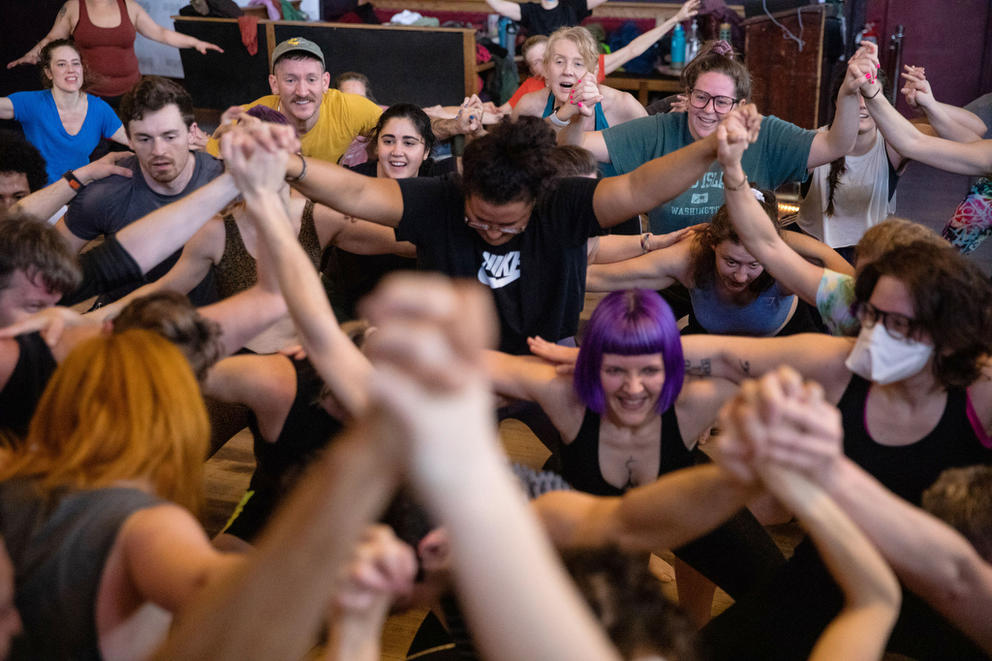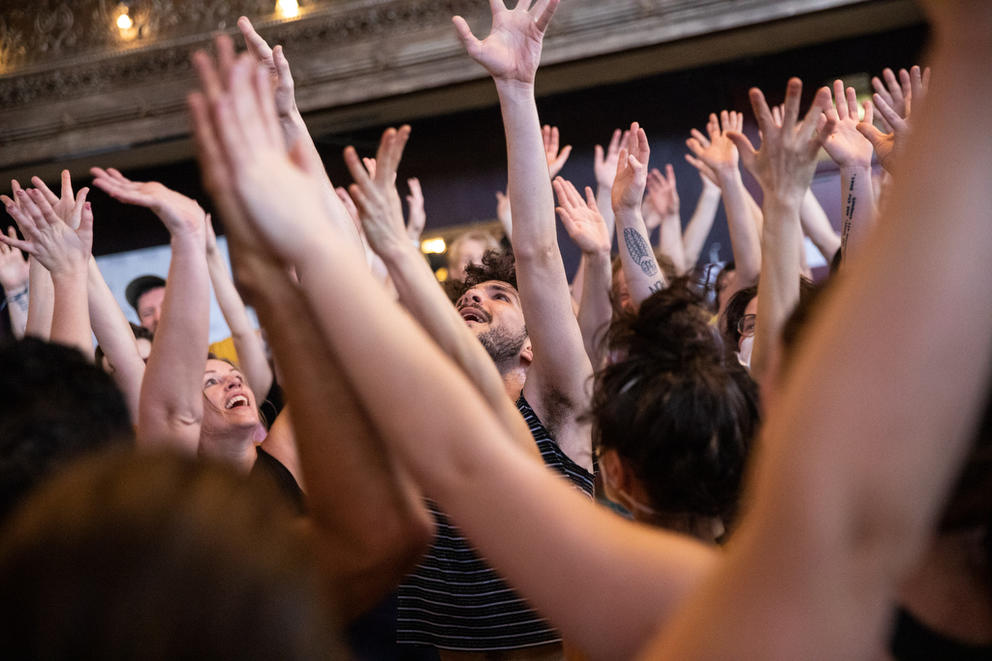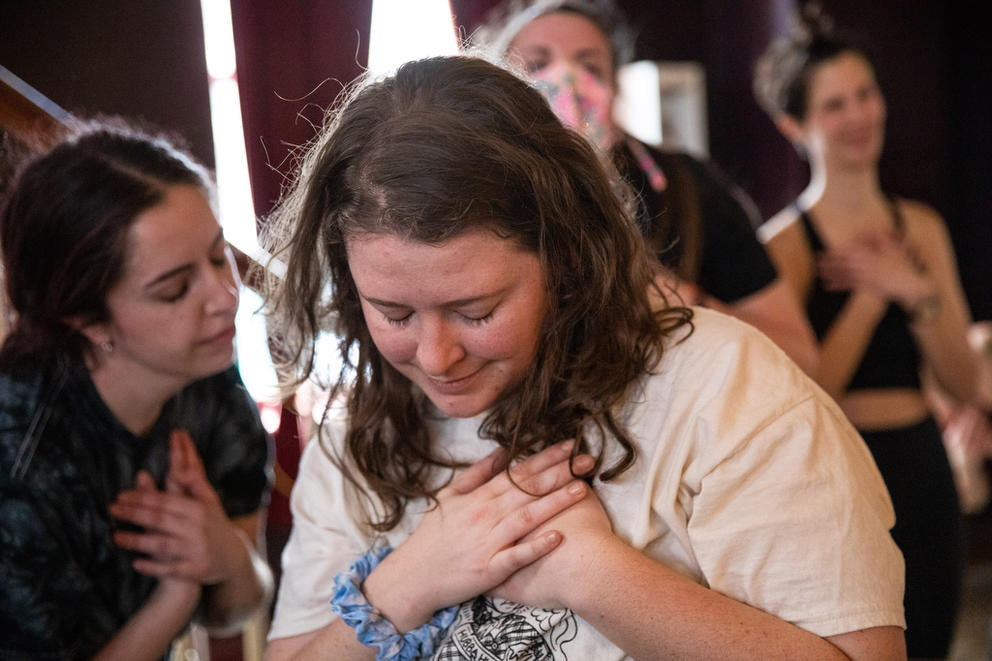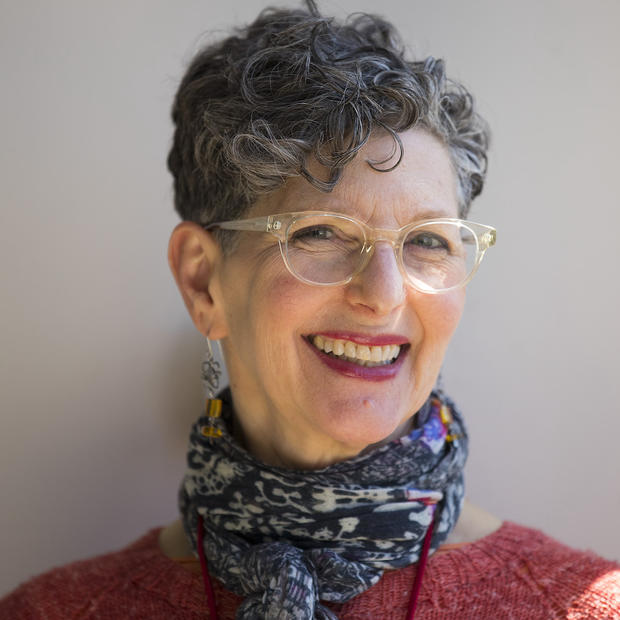The capacity crowd filled the second-story venue for one of four weekly Seattle classes hosted by the dance/movement program Dance Church, held here and around the city. Devotees come to sway and shimmy, waving their arms and pumping their fists to the teacher’s energetic instructions. Tariq Mitri — all but invisible at the center of this crowd — led participants through a nonstop hour of vigorous dancing.
Passersby on the sidewalk below might have wondered whether this was a high-energy exercise class or an ecstatic spiritual ritual.
For many regular attendees, Dance Church classes are about more than movement; they’re mini-communities, a place to set aside their worries and dance together with a big group.
“Dance Church is about immersing yourself with other people,” Mitri says, during an interview a couple of weeks before this class convened. “Sharing that energy that comes off your body and is spinning around the room.”
Clearly, the formula has struck a chord: Since its founding more than a decade ago, Dance Church has attracted a following that organizers hope to build on as it expands across the country.
Among the deluge of news about post-pandemic financial travails that have beset most arts organizations, forcing permanent layoffs or reduced programming, Dance Church’s pandemic story is a bit like the children’s tale about the little engine that used the power of positive thinking to drag itself up the steepest of mountains.
In Dance Church’s case, an “I think I can” attitude has pulled along dozens of dancers who have depended on the organization for regular income and has attracted thousands of new fans.
“It’s like something really magical and special is happening here,” says founder Kate Wallich. “And I do think it can be big.”
Wallich may be right. With an infusion of more than $4 million in venture capital, a new business-savvy CEO and widening demand generated by an expanding online audience, the Seattle-based program has started down the path toward becoming a business that can provide regular classes for fitness devotees, living wages for its employees and an opportunity for trained dancers to earn enough money as instructors to support their careers.
In January, Dance Church leaders launched a nationwide campaign to recruit new teachers, offering paid training, financial incentives and the chance to join a company that more than tripled its audience during the pandemic. So far they’ve heard from interested people in Hawaii, the Midwest, Texas and beyond.
Dance Church foundations
Wallich, who grew up in Michigan and graduated magna cum laude from Cornish College of the Arts in 2010, didn’t set out to build an exercise empire when she held her first Dance Church class more than a dozen years ago. At that point already a well-respected contemporary dancer and choreographer, Wallich was looking for an alternative to the dance classes she’d attended all her life.
“I started it because I needed a place to belong in Seattle,” Wallich says, “a place that wasn’t focused on dance technique.”
Wallich organized her first class in 2010 in a rented studio in Pioneer Square. She and her longtime friend and dance partner Lavinia Vago invited a small group of people to join them for an hour of experimental movement.
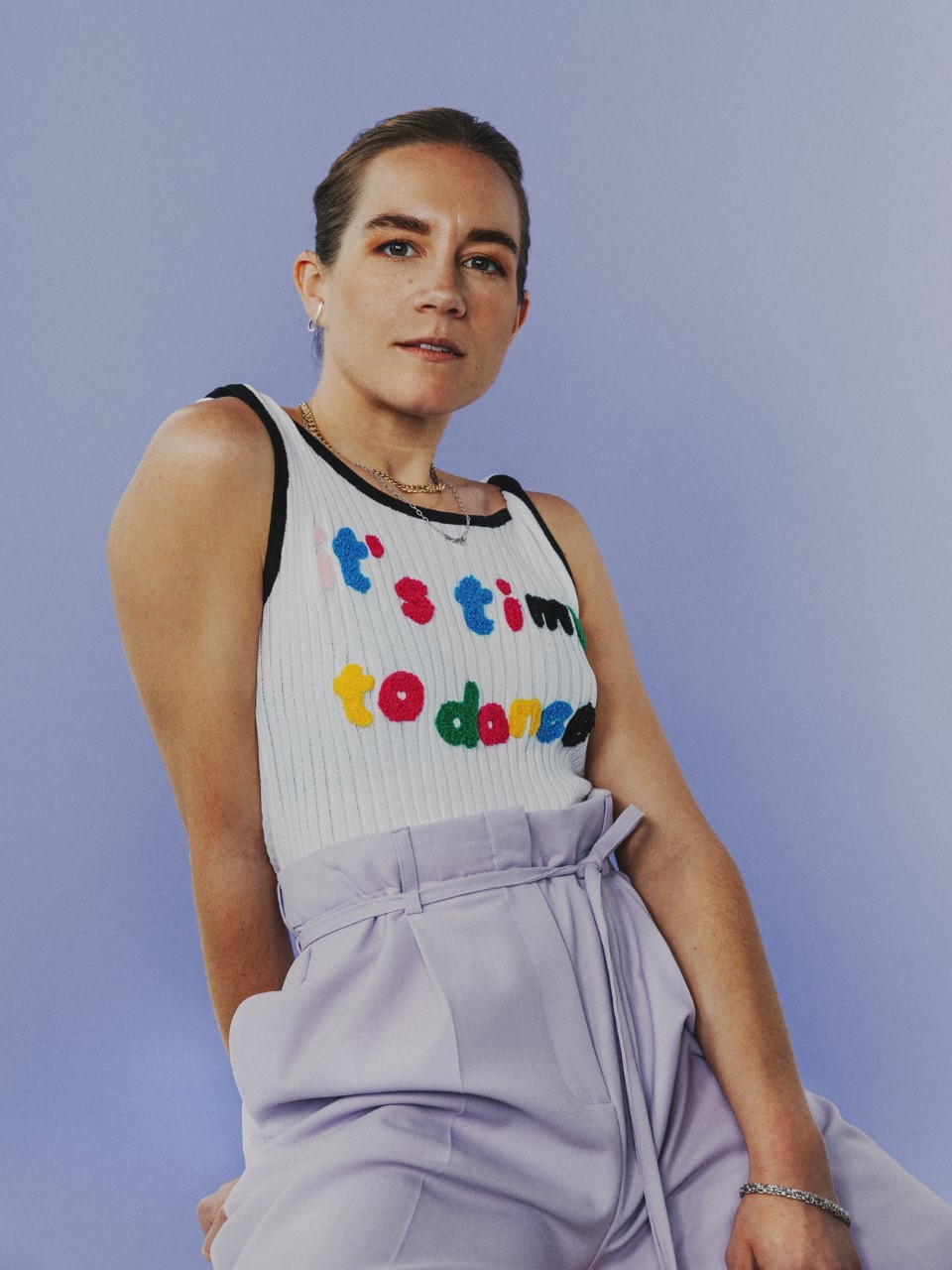
“The format was very loose,” Vago recalls. “There were, like, 12 people, and we were just moving around, trying to stay away from dance terminology.”
Vago and Wallich wanted to create a judgment-free environment for people to share the joy the two of them found in dancing. There were no prerequisites for participation. The movements were simple, from lunges and kicks to twerk-like hip gyrations.
The idea was to create a place where anyone — no matter their age, race, gender, body type or physical abilities — could dance with a group of people. The result: a kind of free-form version of dance/exercise programs like Jazzercise or Zumba.
That first class led to another, then evolved into a regular weekly event. Eventually it outgrew the Pioneer Square space and migrated to the former Velocity Dance Center space on Capitol Hill. Ultimately Dance Church outgrew both its original space and its once-a-week schedule.
The Sunday faithful
Even though participants — and teachers — use words like “transcendent” and “euphoric” to describe how they feel after a Dance Church session, the organization isn’t affiliated with any kind of religious group, unless you define live performance as your sanctuary.
Wallich didn’t even come up with the name Dance Church. “The students named it,” she says. “It was happening on Sunday mornings and it became a ritual for people.”
Although they don’t adhere to a strict regimen, Dance Church teachers do follow a set arc in each class starting with a slow warmup that segues into some heavy-duty movement that looks more like club dancing than the type of tightly choreographed routines typical dance classes offer.
At the end of class, teachers invite the participants to lie down together to cool off, a moment that, during the in-person classes, resembles 200 people simultaneously hitting the floor to execute yoga’s savasana pose.
Within that set framework, participants are free to adapt the teacher’s instructions to their own abilities. There are no fitness or weight-loss goals, no exhortations to lift an arm or leg higher or faster.
“People come because they want a good workout, or they’re experiencing a trauma in their lives, or they want to meet new people,” Wallich says. “There’s so many entry points, but people come in and then have an amazing time.”
Seattle writer Angela Garbes has been a Dance Church regular since 2015. She’s taken other fitness and dance classes over the years and loves to move her body, but for Garbes, Dance Church is as much about the relationships with teachers and other attendees as it is about getting a good workout.
“For me it’s a physical group release,” she says, “being part of a community.” Garbes, the mother of two school-aged children, spends most days dividing her time between parenting and her writing career. The weekly Dance Church class she attends helps her to let go of everything she’s mulling and simply connect with how her body feels when she’s moving.
“It’s comforting,” Garbes says. “Plus, dance helps me become a more fully embodied person; the physical activity transcends my work.”
Like so many attendees, Garbes first heard about Dance Church from a good friend, and shared her positive experiences with other people she knew. Word-of-mouth has fueled a slow but steady organic growth, pushing Wallich to add more weekly classes to the schedule and recruit more instructors from Seattle’s widespread dance community.
According to Vago, by 2019 Dance Church was offering seven sold-out classes a week in Seattle. “People would line up out the door for an hour beforehand,” she says. “They couldn’t get in because the class was full.”
From the pandemic, possibility
As it was growing in Seattle, Wallich started regular Dance Church classes in Portland, New York City and Los Angeles, and held pop-up sessions in other locations around the country. By early 2020, Dance Church had attracted more than 40,000 regular in-person attendees. It seemed like an unstoppable wave.
Then came COVID-19.
Dance Church immediately shut down its in-person classes. Like so many performing artists, Wallich and the dancers she worked with were devastated by the simultaneous loss of income from both performance opportunities and teaching Dance Church classes. And, like so many arts organizations, they decided the only way to survive was to start live-streaming.
“I had this gut feeling that said COVID just wasn’t going to go away,” Wallich recalls. “We needed a plan.”
The first online class took place March 15, 2020, making Dance Church one of the first arts groups in Seattle, if not the nation, to go all-digital. “We were the first to do it [live-stream], and because we’d spent more than 10 years building a community, the word spread fast.”
1,000 people attended the first online class; a week later almost 3,000 participants attended the live stream. “It was so beautiful to see the world turn to dance in such fearful times,” Wallich says.
While it was born of desperation, “moving online was kind of one of the best things that ever happened to Dance Church,” Wallich admits. “Before, it was ‘Show up with $20 cash,’ and I had to figure out class registration and banking. It was a mess, you know?” The necessary shift pushed Wallich to think more strategically about everything from how to build out a custom digital presence to how to raise the money to pay for it.
As an artist accustomed to producing and promoting shows of her own works, Wallich is fairly business-savvy, but she realized she needed somebody with more professional experience not only to keep Dance Church afloat, but to help it grow.
In 2021, the organization partnered with a Seattle tech group called Pioneer Square Labs and, at its recommendation, hired Clara Siegel, Dance Church’s first non-dancer employee, as CEO.
Upon arrival, Siegel told Wallich, “‘Hey, these 15 things that are technical or legal, I can carry that to free you up,’” Siegel recalls. “What I did was bring some structure, so it could be less stressful and the dance artists who were doing the actual work could be fairly paid.”
While Siegel organized aspects of fundraising, bookkeeping and systems development, the rest of the team could focus on training the new teachers they needed to provide a solid foundation for Dance Church’s expansion.
Soon after Siegel came on board, she facilitated a $4.7 million dollar cash infusion, the majority of it from the venture capital firm MaC, a Black-owned fund that has invested in many BIPOC- and women-led businesses.
MaC partner Zhenni Liu says that initially, the company was interested in how Dance Church fit into what they saw as the growing consumer market for fitness and wellness programs, especially the online offerings that sprang up during the early months of the pandemic.
MaC is specifically focused on providing what Liu calls pre-seed funds, at a company’s early stage. Dance Church fit the bill, having shifted in 2019 from a nonprofit organization to a for-profit company.
“Beyond that,” Liu says, what held appeal for the firm was “Dance Church’s community factor, [and] the LGBTQ population that was overlooked by traditional wellness programs.”
The venture capital initially went to pay teachers, secure music licenses, and to market the digital classes the company had started to film (at the On the Boards performing arts space in Lower Queen Anne) and stream at regularly scheduled class times.
Now that Dance Church has returned to in-person classes (in addition to continuing video-on-demand classes), the remaining funds go to salaries, venue rentals and streamlining operations. Liu says MaC still meets monthly with CEO Siegel and retains a seat on Dance Church’s Board of Directors.
Predecessors in Jazzercise and Zumba
By early 2022, Dance Church’s live streams had attracted nearly 150,000 participants around the world — more than triple the pre-COVID in-person attendance — so Siegel and Wallich knew there was a national audience at the ready. Together with Vago and the other dancers who make up what’s called the Dance Church HQ team in Seattle, they developed a plan to scale up across the United States and eventually into European markets.
One of Siegel’s big tasks was to research economic models for other dance/movement programs. Two of the biggest brands are Jazzercise and Zumba.
Jazzercise was founded in 1969 by Judi Sheppard Missett, a studio dance teacher who was looking for a way to bring “jazz dance for fun and fitness” to adult women. Though its heyday was in the 1980s, Jazzercise still has more than 8,500 franchises around the world, offering 32,000 classes a week in 25 countries. Prospective Jazzercise instructors pay an initial $1,250 for certification and the right to operate their franchise. (Missett, at 79, still teaches regularly.)
Choreographer Beto Pérez — former winner of a national lambada contest in his native Colombia — founded Zumba in 2001, combining aerobics and various Latin dance styles. As with Jazzercise, aspiring Zumba instructors pay for training and a license to operate under the Zumba brand name. According to the Zumba website, more than 12 million people are taking classes in 125 countries. Zumba teachers earn $15-$20 per hour depending on location.
By contrast, Siegel points out that Dance Church has committed to pay teacher trainees for their time. Once they’re ready to lead classes, these teachers will work for Dance Church rather than operate franchises. The plan is to offer new teachers outside the core Dance Church cities $100 per class plus $3 per student.
In Seattle and the three other cities where the company currently offers regular classes, Dance Church instructors earn $250 per class. In addition, they’re paid $20 an hour for time spent in meetings and extra training, or for travel to conduct pop-up classes.
Siegel points out that if a new teacher travels to Seattle to lead a class, they’ll earn the same rate of pay as local instructors. As teachers in new locations grow attendance or expand their class offerings, their pay goes up.
Dance Church also will provide funds to subsidize phone bills, rent class space, even underwrite Spotify playlist fees. The idea is to incentivize program growth while retaining control over the Dance Church brand.
At this point, Siegel and the team aren’t publicly sharing target growth numbers. But they’re laying the foundations for what Siegel calls sustainable scalability, including by implementing a membership structure.
Siegel also helped create an online registration portal, so teachers no longer have to turn away hopeful participants at the door or keep track of cash payments during the hectic rush before class. Prospective Dance Church participants now register online, paying $49/month for unlimited access to in-person and on-demand video classes. Lower membership rates are available for people open to more limited access, as well as for dance artists who’d like to take classes.
More than 12,000 members attended in-person classes in 2022 — a baby step when compared to the Zumba and Jazzercise juggernauts. But while the company won’t share online attendance figures, Siegel does say Dance Church is thriving.
Siegel’s arrival at Dance Church was a watershed for a company that was poised to move in new directions. Her business background and her decision to take over many of the administrative tasks opened the door for Wallich to do what she and her team of dancers do best: think creatively about how to grow programs across the country.
Making dance economically sustainable
To be clear, Dance Church isn’t looking for fitness trainers or gym rats to teach classes. From the beginning, Wallich has sought professional dancers as leaders. For the founders and HQ team, this is key to Dance Church, and what separates it from other movement programs.
“We want to truly support dance artists in a field that is often underfunded,” co-training manager Tariq Mitri says. Mitri, who’s been teaching Dance Church classes since 2017, says one of the program’s fundamental missions is to help dance artists not only teach but maintain their artistic practices.
“We want to give them more access to a stable lifestyle where they don’t have to pour tons of time into other jobs, where they can bring dance to everyone and still focus on their career.”
Mitri is one of seven full-time Dance Church employees, earning a salary and full benefits. Other teachers are hired part-time, as W-2 employees, meaning that the organization deals with taxes. But unlike many freelance dance instructors, Dance Church teachers also get access to sick leave, retirement and unemployment benefits if needed.
Beyond financial support, Dance Church offers employees the flexibility to arrange their schedules around rehearsals, touring and other artistic commitments.
Lavinia Vago, who now serves as Dance Church’s full time Director of Programming, still has to juggle this day job with making art, but her life is much more manageable than it was pre-Dance Church.
“Before, I had, like, 10 gigs: art modeling, babysitting, catering. I think this can really be a support system for dance artists around the world,” she says. “They can have a way to support themselves, to find community and bring them into dance. At a really massive scale.”
Dancing into the future
As Dance Church expands, the trick will be staying true to the qualities that have helped it build its fervent following — a philosophy that welcomes a diversity of people into a community based on the love of dance. For CEO Siegel, those values, rather than spreadsheets and data sets, have actually been a selling point when she meets with potential investors.
“When you’re on the business side, it does typically help to show how you’re competitive and all that,” Siegel says. “[But] we’re really honest, we’re like ‘This is who we are, you can see it’s meaningful to people.’” And like-minded investors, as well as corporate partners like Nike and Nordstrom, have stepped up.
According to MaC partner Liu, who attends in-person classes when she’s not traveling for work, Dance Church’s value-centric mission is one of the reasons her company invested in the first place. “We’re very excited about the trajectory for Dance Church to expand across the country, and eventually worldwide,” Liu says.
Dance Church’s push to recruit teachers and expand into new communities is still in its early days, but Siegel and the other members of the team are optimistic about continued growth.
The program Wallich created in 2010 has eclipsed her personal direction. During the pandemic, she quietly relocated to Los Angeles, where she still sometimes teaches Dance Church classes. And for the first time in several years she has the time and energy to head back into the studio to work on new choreography.
But Wallich doesn’t really differentiate between her choreographic career and her work with Dance Church. She likens it to an infinity symbol: a never-ending spiral that brings people to her classes, introduces them to dance artists, then sends them back into the world to spread the good word about both Dance Church and contemporary dance.
“I have birthed this thing that others are leading and guiding now,” Wallich reflects. “That is a piece of work in itself. Honestly, it’s kind of like the biggest dance I’ve ever made.”
Get the latest in local arts and culture
This weekly newsletter brings arts news and cultural events straight to your inbox.




